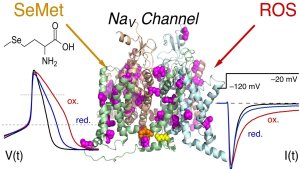SeMet-containing sodium channels
SeMet-containing sodium channels
Illustration: FSU BiophysikSelenomethionine (SeMet), which is used as food supplement for its antioxidative properties, readily replaces methionine (Met) in protein synthesis. Here we found that SeMet incorporation in voltage-gated sodium (NaV) channels fully supports channel function. However, SeMet-containing channels become much more sensitive to reactive oxygen species (ROS) with loss of channel inactivation being the most prominent phenotype. This reversible gain-of-function is also observed in DRG neurons cultured in SeMet-containing medium. SeMet incorporation in NaV proteins coinciding with oxidative insults may therefore result in hyperexcitability pathologies, such as cardiac arrhythmias and neuropathies, like congenital NaV channel gain-of-function mutations.
